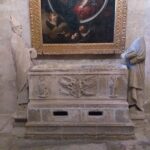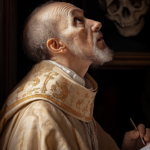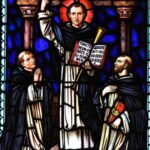St. Abban
Saint Abban
St. Abban
When they lived:
St. Abban, also known as Saint Ewin and Saint Aibenn, lived during the early 6th century. His exact birth and death dates are not well-documented, but he is believed to have been born around 520 AD.
Where they lived:
St. Abban hailed from Ireland, specifically County Wexford, which is located in the southeast of the country. He spent much of his life in this region, where he became renowned for his piety, wisdom, and sanctity.
Notable world events during the time of their life:
- The fall of the Western Roman Empire (476 AD): During St. Abban’s lifetime, the Western Roman Empire faced its final collapse in 476 AD. This event marked the end of an era and the beginning of the Middle Ages, which greatly influenced the historical context in which St. Abban lived and spread his teachings.
- The Age of Saints in Ireland: St. Abban lived during a period known as the “Age of Saints” in Ireland. This era, from the 5th to the 7th century, saw the emergence of numerous holy men and women who became influential figures in spreading Christianity across the island. St. Abban was one of the prominent saints of this era, contributing to the Christianization of Ireland.
- The Byzantine-Sassanid War (502-506 AD): During the time of St. Abban, the Byzantine Empire was engaged in a war with the Sassanid Empire, a major conflict between the Eastern Roman and Persian empires. This war had significant geopolitical implications and cultural exchanges, which might have indirectly impacted the spread of Christianity during that period.
Their patronage:
St. Abban is venerated as the patron saint of many aspects, including:
- Patron Saint of Agriculture: St. Abban is believed to have had a deep connection with nature and the land. As a result, he is revered as the patron saint of agriculture, with people seeking his intercession for favorable weather conditions, bountiful harvests, and fertility of the soil.
- Protection against Plagues: During his lifetime, St. Abban was reputed to have performed miraculous healings and protection against contagious diseases. As such, he is invoked as a patron saint to protect against plagues and illnesses.
- Fertility and Family Harmony: St. Abban is also recognized as a patron saint of fertility and family harmony. Couples seeking children and families in search of unity often turn to him for blessings and prayers.
- Navigators and Mariners: Legends say that St. Abban, despite being landlocked in Ireland, had a strong affinity with the sea. Thus, he is invoked by navigators and mariners for safe journeys and protection on the waters.
Interesting Facts:
One of the most intriguing aspects of St. Abban’s life is the establishment of several monastic foundations attributed to him. Notably, he founded the monastery of Magheranoidhe in Wexford, which later became a renowned center for learning and religious study. Additionally, St. Abban was known for his humility, kindness, and generosity, making him beloved among the local people and contributing to his widespread veneration.
Early Life
What is known about Saint Abbán is gleaned from the documents that were written about him.
Only three documents about Saint Abbán were said to have survived in recent times, two written in Latin and one in Irish. Although incomplete, they tell the story of Saint Abbán.
There are numerous accounts of who this man could have been. These accounts differ greatly, and it is not known for sure what Saint Abbán’s entry could have been.
One thing is certain: Saint Abbán was of Irish descent. Some of his biographies state that he was of the U Chormaic Irish clan, sometimes called the Moccu Chormaic clan.
He was born Circa 570. His father was said to have been a Laignech or Leinsterman. He came from a long line of distinguished noble families.
Other documents, however, claim that his father was Cormac, prince of Leinster. This version claimed Saint Abbán’s mother was Mlla, a sibling of Saint Ibar.
There is no detail about how Saint Abbán lived his early years. Some documents state that he was set to be heir to the throne of Leinster. He was, however, more interested in pursuing his spiritual needs and declined the offer.
Dedication and Devotion
Saint Abbán was a devoted young man. He knew he was destined for greatness in his church. He also performed several miracles that convinced his father that he was meant for great acts.
Saint Abbán was sent to live with his mother’s brother, Saint Ibar, who was at that time a bishop. Together, they traveled to Rome to minister to the people.
It is said that Saint Abbán wielded such great power that he used it to chase off dangers from men, monsters, and animals. In various documents, it is said that Saint Abban also wielded the power of the Seasand Rivers.
Saint Abbán, throughout his biographies, was associated with various saints like Saints Finnisn and Saints Brendan. He was also placed in places like Ireland, where he was said to have preached to the people.
Saint Abbán was said to have planted Churches after returning from Rome for the second time. He was said to have pioneered several churches, like the Cell Ailbe, Camross, and a monastery in County Carlow.
Legacy
Some writers argue that Abingdon, a town near Oxford, adopted the name in reverence to Saint Abbán. They reckon that this was because he had preached to the King and the people at that time and converted them to Christianity.
Saint Abbán is associated with various religious happenings. However,probably due to his existence quite early on and the absence of documentation, his works are not known for sure.
Saint Abbán was said to have established many chapels in places that are now known as County Wexford and Ferns.
He founded a convent in Magheranoidhe, modern-day Adamstown. He was also said to have founded a monastery and served as Abbot in Leinster until his death.
What is known, however, is that this missionary and prince who wielded so much power played an important role in the early Church.
Death and Canonization
Saint Abban died on the 16th of March, 620 A.D. He passed away in modern-day Wexford, Ireland.
Saint Abbán was canonized Pre-Congregation. He is commemorated on the 16th of March and the 27th of October.
5 Interesting Facts About Saint Abban
- Did you know that modern-day Adamstown was once called Abbanstown?
after Saint Abbán? - Did you know that Saint Abbán’s sister was said to have been Saint
Gobnait? - Did you know that Saint Abbán was said to have founded a church in
Ballyvourney? It is said that he bequeathed it to his sister. - Did you know that Sainr Abbán was said to be buried next to the
convent in Ballyvourney? - Did you know that Saint Abban is the patron Saint of Mag Arnaide?



